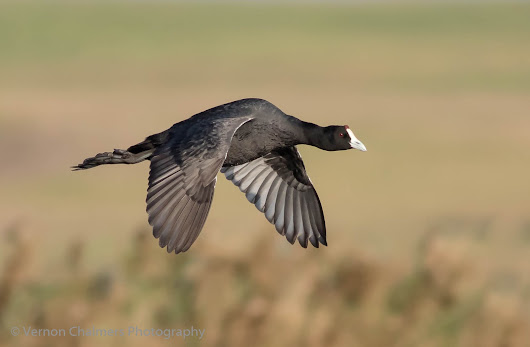 |
| Red-Knobbed Coot in Flight - Woodbridge Island, Cape Town |
How To Do Birds in Flight Photography
"Birds in flight photography is a challenging and rewarding genre of wildlife photography that focuses on capturing images of birds while they are airborne. It requires skill, patience, and proper equipment to capture stunning shots of birds in motion. Here are some tips and techniques to help you improve your birds in flight photography:
1. Equipment:
- Camera: Use a camera with a fast autofocus system and a high continuous shooting speed to capture the fast movements of birds.
- Lens: Choose a telephoto lens with a long focal length (300mm or more) to bring the birds closer and isolate them from the background.
- Tripod: While shooting birds in flight, it's best to handhold your camera for flexibility and mobility. However, if you're using a heavy telephoto lens, a sturdy tripod with a gimbal head can provide stability and reduce fatigue.
2. Camera settings:
- Shutter speed: Use a fast shutter speed (1/1000 sec or faster) to freeze the motion of the birds and prevent motion blur.
- Aperture: Select a wide aperture (low f-number) to achieve a shallow depth of field, which helps isolate the bird from the background and create a pleasing bokeh effect.
- ISO: Set the ISO value to achieve a proper exposure while maintaining image quality. Start with a low ISO and increase it if needed in low-light conditions.
- Autofocus mode: Use continuous autofocus (AI Servo or AF-C) to track the moving birds. Select a single-point or small-area autofocus mode to maintain focus on the bird's eye.
- Burst mode: Enable the continuous shooting mode to capture a series of shots in quick succession, increasing your chances of getting a sharp image.
3. Composition and technique:
- Anticipate the action: Study the behavior of birds to anticipate their flight patterns and movements. Position yourself in a location where birds are likely to fly, such as near their nests, feeding areas, or migration routes.
- Tracking the bird: Keep the bird within the autofocus point or zone and track its movement smoothly. Follow through with your motion even after taking the shot to avoid abrupt camera movements.
- Background and lighting: Pay attention to the background and lighting conditions. Look for clean, uncluttered backgrounds that won't distract from the bird. Shoot in soft, warm light during the golden hours (early morning or late afternoon) for pleasing results.
- Experiment with angles: Vary your shooting angles to capture different perspectives. Shoot from low angles or try panning the camera to convey a sense of motion.
4. Post-processing:
- Review and select: After a bird photography session, review your images and select the best shots based on composition, sharpness, and overall appeal.
- Crop and frame: Use cropping to enhance the composition and remove any distractions. Consider the rule of thirds or other compositional guidelines to create a visually pleasing image.
- Adjust exposure and colors: Use post-processing software to fine-tune the exposure, contrast, saturation, and colors of your images. Be careful not to overdo the adjustments, aiming for a natural look.
Remember, birds in flight photography requires practice and persistence. It's essential to respect and observe the birds' behavior without causing any harm or disturbance. Enjoy the process and keep honing your skills to capture stunning images of birds in flight." (Source: ChatGPT 2023)
Setup and Tips For Canon Birds in Flight Photography >>
Birds in Flight Photography Training Cape Town >>Environmental Variables for Improved Birds in Flight Photography >>